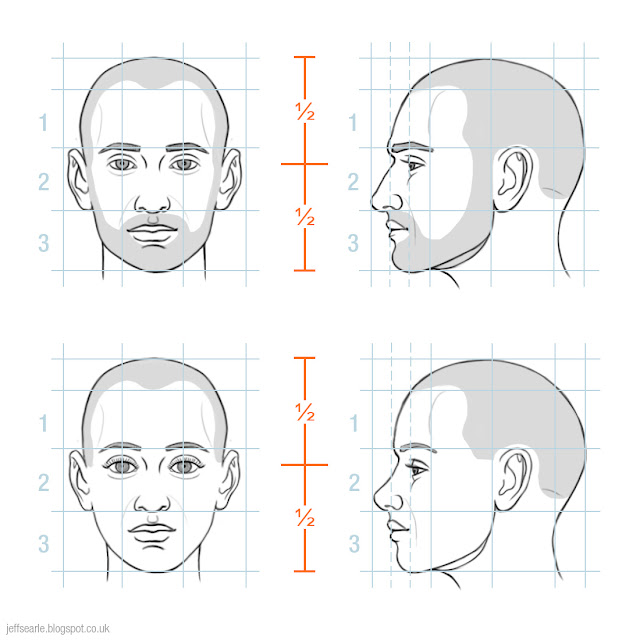The front view of the human head fits quite well into a rectangle three units wide by three and a half high. The side view fits into a square three and a half units in each direction. You will notice that the head is deeper than it is wide. That’s why we have to add a bit extra to the back of the head when constructing our ‘divided ball and plane’ model. But the proportions discussed here fit fine with that model, because they too are based on reality. Note how we have three ‘thirds’ starting from the hairline, like on the ball-and-plane model. If you imagine the ball of the ball-and-plane, the width of the ball before you slice the sides off is the width of the head including the ears.
The dividing lines of the units help us locate all the features: hairline, eyebrows, eyes, nose, ears and mouth. We can easily see three rough divisions of the face (forehead, nose and jaw). The eyes fall on the vertical dividing lines, and sit at the centre of the whole head from top to bottom, as indicated in orange. In the front view there is a bit of space beyond the ears on either side. The face (as opposed to the whole head) is about two units wide. On the right-hand heads in the illustration you can see two extra divisions using dotted lines, which approximately mark the front plane of the face (as opposed to the tip of the nose) and the front of the eye.
Not everyone has their eyes exactly halfway up their heads, and some people have very short or long noses, etc. But for the majority of us, these proportions hold true, and the variations don’t normally diverge from the average all that much. Gary Faigin observes:
When there are exceptions to this rule, it’s usually the central third that varies from this arrangement.
(The Artist’s Complete Guide to Facial Expression)
About 30% of us, he says, have noses that are shorter than the regular distance, i.e. from the base of the nose to the chin. People in whom that distance is longer are extremely rare.
I have included male and female examples, but in terms of proportions, male and female heads are much the same. The male is more robust, with lower brows and larger features. The female bone and muscle structure is lighter and less prominent, the eyebrows are a bit higher, and the features are smaller. These differences affect the overall proportions very little. We will look at male/female differences in more detail another time.
These measurements offer an easy-to-use and practical scale – there are other methods, and you may prefer them. Just remember they are tools, not rules. What matters is achieving the drawing you want. If you’re drawing someone’s portrait, these measurements will help you sketch out the major forms of their head, but you want to draw your subjects as they really are, not as they would look with their features distorted to fit into a pre-supplied grid. Diagrams like these also stop being useful as soon as you draw the head at an awkward angle. They are no alternative for drawing lots of real heads at many angles to thoroughly learn the proportions and relationships.
Useful rules of thumb
Here are a few rough measurements we can use to help us get our proportions right.
1. If you join the outer corners of the eyes and the bottom middle of the lower lip you get an equilaterial triangle.
2. You also get one if you join the the bridge of the nose, the chin and the corner of the jaw.
3. The width of the eye viewed from the front is a useful measurement. There is an eye’s width between the eyes, and an eye’s width between the corner of the eye and the edge of the face. The same measure also gives you the width of the base of the nose.
4. The bottom of the nose is halfway between the browline and the bottom of the chin. The bottom of the lower lip is halfway between the bottom of the nose and the chin.
The head and the skull
The illustration below shows the division of the head with reference to the skull.
The grey dotted lines indicate the three main divisions – the orange line marks the middle of the whole head. You can see how the browline sits on the bony prominence of the superorbital ridge above the eye socket. The noseline sits at the bottom of the nose socket, shaped like an inverted heart, where the nasal spine marks base of the nose. The lowest division lines up with the edge of the mandible or jaw bone.




No comments:
Post a Comment
I welcome contributions to this blog. Comments are moderated.